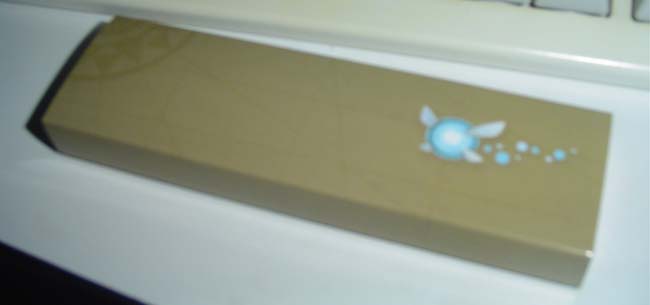
My fondest memories can more or less be summed up in three categories: “Shopping at Toys ‘R’ Us”, “Holidays/Trips”, and “The Cottage”. The first two categories can still potentially be added to, but sadly, the third is now sealed away as only memories.
I’ve mentioned many a time on this website (most often in the blog) my many visits to my grandparents’ house, which just happened to be a sweet cottage out on the Winnipeg River. The thing is, I never described many events in detail, or took any pictures while I was out there. to nearly everyone, this mysterious cottage could have just as well been a well-constructed myth. To me though, it was very real, and it was the essence of my summers. I spent at least two weeks out there during the summer months for as long as I can remember, and there were quite often other trips out there for such events as Spring Break, Christmas, Thanksgiving, family reunions, long weekends, and many more. It was a great place, and while I may not have appreciated it quite as much in my older years, it was still a place I loved being very much.
Imagine my heartbreak when I first heard that my grandparents were thinking about selling. As if enough bad mojo wasn’t surrounding me in the year 2007, but now my beloved cottage was going to be taken away? Yeah, it sucks balls. The place was actually sold right at the end of August, and on my last weekend out there, I decided I would take a few pictures so I could put them on a webpage laced with wonderful stories of the time I’d spent there. This is that page, and it’s definitely more for my own sake than for anyone else to read, but feel free to sift through it. There are a lot of memories and strong emotions here, so don’t expect even an attempt at humour.
The TV Room
Overview: Ah, the TV room. I probably spent more hours here than anywhere else, but there are a couple catches that help to make that seem less like I was glued to the TV for all the time I was at the cottage. The most obvious one would be that for a couple years I used one of the couches as my bed, so that racks up the hours pretty quickly. If I regret anything in my lifetime, it’s that I didn’t spend nearly enough time out on the balcony that extends from this room. Don’t know why, but it just never seemed like the place I should be hanging out.
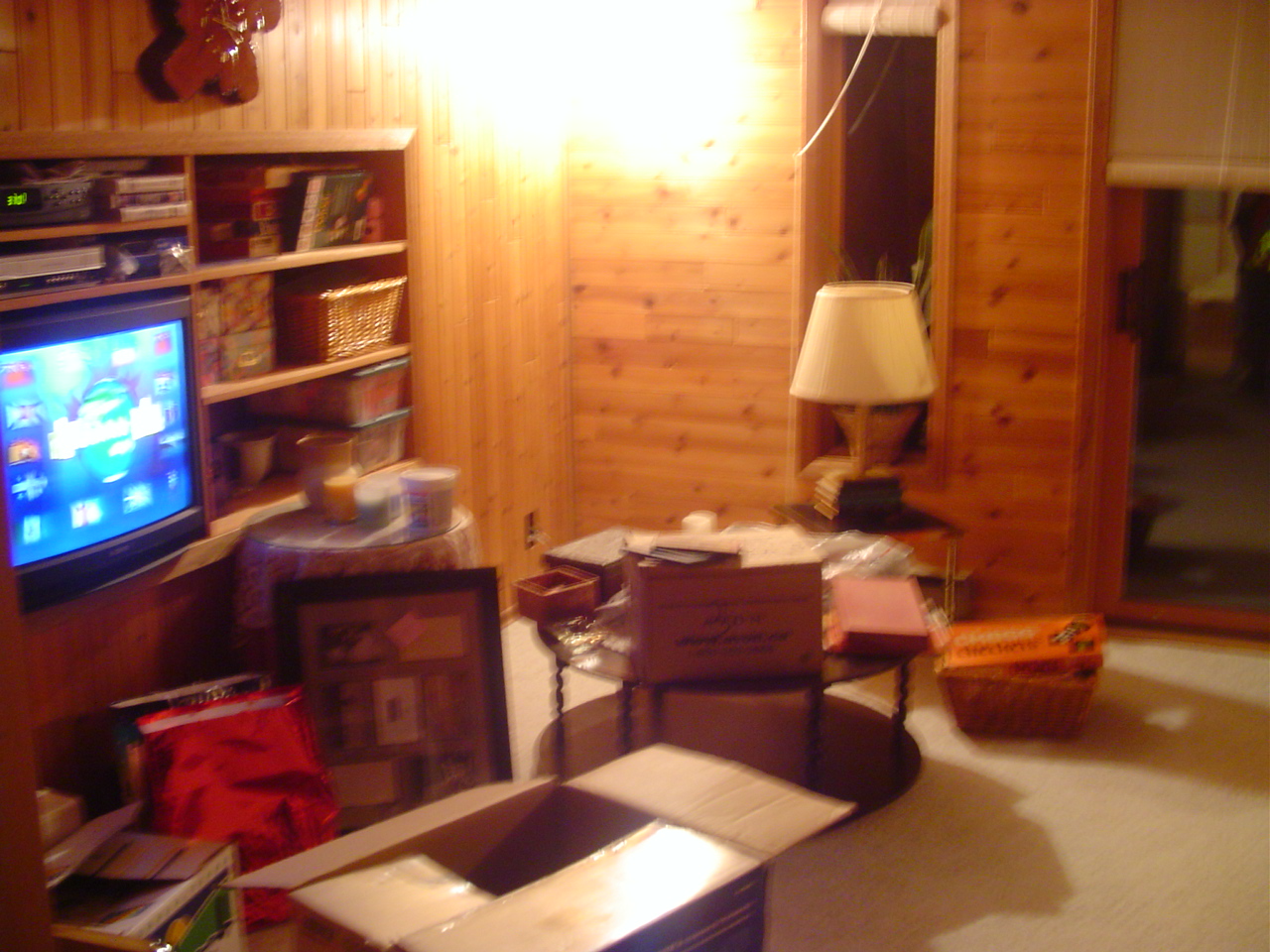
Atari: I guess the earliest thing I can remember this room for is that it’s where we had out Atari. Long before I got hooked on video games, my dad left his Atari system out here, only to be dug up many years later so he could show me the kind of games that were around before the NES. I spent many many hours playing Kangaroo, Pitfall, and Pac-Man. Even back when I was only but a wee lad, I could recognize that ET was the worst game ever made. The biggest mystery about the whole thing though, was that we had a manual for Donkey Kong, but there was nary a cartridge to go with it. Oh, how I burned to play Donkey Kong.
Simpsons & Bonding time: My younger cousin would often come in to visit at the same time we did in the summers, and it worked out well because he’s very much like me, so myself and The Youngest One would often spend a lot of time hanging out in here with him and playing whatever handheld game was in at the time. Or just whatever the most recent Pokémon game was. Those two are even more into Pokémon than I am, and I would always get into it when we came out to the cottage, because the young ones just wouldn’t shut up about it, and that would drag me into it. The Tall One and I were also deeply entrenched in the MegaMan Battle Network series, and it was pretty much a summertime tradition to buy the games just before we went out the cottage and simply play the Hell out of them while we were there. Both series of games brought me not only the regular pleasure of playing video games, but also a lot of valuable bonding time with my brothers and cousin. Sure, I can still play with them at home, but it’s just not the same. Also, my grandparents got satellite TV a few years back, and it seemed like that on any given evening that we were there, the Simpsons would always be on at least one channel, so we generally always had that on in the background. Good times, they were. Good times.

Movie night: Back in the day, my grandpa would often borrow a bunch of movies from a neighbour so we had something to watch while we were out there (this was before the satellite, and we were restricted to like three fuzzy channels). This is notable because it’s the first place I ever saw Kindergarten Cop, which remains my favourite Schwarzenegger film, and is near the top of my overall favourites. Many other times, while my grandparents were staying in the city, my family would come out for the weekend and basically binge on junk food and watch movies. Most of them were stinkers like RV and Epic Movie (to name some of the most recent), but it was still cherished time spent with my family and many, many cookies.
Random thoughts: It was a great place to hang out, and of course we often brought more in the way of video games than handhelds, as Atari was fun, but never quite enough. We fought over which console we would bring each time almost as much as we fought over who got to sit in that big reclining chair you can see in the second picture. I played a lot of Donkey Kong 64 out here, and that particular week at the cottage remains one of the most memorable for many reasons. I’ll always carry in my heart the memories of the first time I caught all the legendary birds in Pokémon Blue, as they were all while I was out at the cottage. I spent many subsequent trips out there playing through the game again and again, always reliving my triumphs over Zapdos, Articuno and Moltres with a smile on my face, often in the middle of the night when I should have been long asleep.
Guest Bedrooms
Overview: Only one is pictures, but there were actually two bedrooms upstairs. While I suppose they weren’t technically guest bedrooms, nobody used them but guests, so there you have it. Until the shed outside was turned into a mini-cottage of sorts (more on that later), we would often sleep in these rooms. For a handful of years I slept in the TV Room, as I mentioned before, but these were where we stayed the majority of the time.

Bedtime: The room you see pictured is actually the final phase of that room’s series of redecorations. Initially it had two huge beds lined against the window wall and the wall opposite the shelving. And when I say huge, I mean huge enough to play underneath with plenty of room to spare. I guess they were more high up than anything else, but while they were in there, I was still small enough to think they were gigantic. Until The Youngest One was born, the older two and I would sleep in this room together, a crib or mattress was placed in the empty floor when needed, and I moved onto the second bedroom room when The Youngest One came along and three beds weren’t enough to satisfy the four of us. But until that time, we spent many nights staying up “late” (back when 10:30 was late) and telling stories and jokes in the dark. Being all boys, there was plenty of roughhousing after bedtime too, and I really miss those times.
Bedtime 2: Eventually, when I moved onto the second upstairs bedroom, I was on my own and free to do whatever I pleased instead of sleeping. Obviously, I used that time alone to play GameBoy, listen to music, and read (most memorably the Final Fantasy VIII strategy guide, because that was another completely kickass summer) all through the night. Once the boys started sleeping outside (in the aforementioned shed) I took over the original room for myself again, and at that point it had been rearranged into the room you see in the picture above.
Comics: You can see the shelving in the picture, but hidden behind the pile of assorted sheets and whatnot is a huge collection of comics. They consisted mostly of Archie, Alf, Heathcliff, and Richie Rich. While those aren’t exactly my first choices in comics nowadays, I was pleased as punch to spend countless afternoons leafing through them. And though it took me a couple years to get the job done, I did eventually read through them all. Taking note of my love of comics, my grandpa started saving me the Sunday comics from the Free Press every week, and every time I went out to the cottage he’d always have a stack of funnies for me to peruse. He still saves them for me to this day, and I haven’t put any time aside to read through them for a while now, so I’ve got a rather large pile in my closet just waiting to be read or thrown out.
Horsin’ Around: Back when we were young, and the huge beds were still in the room, my brothers and I spent a lot of time playing in there, often concluding in someone being injured, however slightly. The number one game would be “Lava Monster”, which I know is not exclusive to us, because I’ve seen characters on TV playing it. But in case you have no idea, basically one person would be the Lava Monster and have to stay on the floor, and anyone else would be trying to stay on the beds while the Lava Monster tried to pull them down “into the lava”. The limited playfield may seem like an issue when I describe it, but it was more than enough when we were just lil’ guys. Plus, we’d always get any other visiting children to join in too, so sometimes the Lava Monsters would amount to more than one, depending on rules (either “Tag” or “Last Man Standing”).
Random Thoughts: Now that I think about it, I guess probably the thing I miss most about the cottage (and childhood in general) was playing with the older two of my brothers. While we still hang out and play video games together now and then, we don’t spend nearly as much time together as we did when we went to the cottage. Back when we were kids, we fought a lot (like, seriously, a lot) at home, but as soon as we got to the cottage, we were like best friends. It’s weird to say because I still see them every day, but I kinda miss my brothers. The Youngest One, I still find plenty of time to hang out with though, so at least I’ve got that. For now.
The Kitchen / Dining Room
Overview: Honestly, the living room, dining room, and kitchen are pretty much all the same room. But that’s hardly the point here. Being the glutton that I am, this area of the house holds just as many lovely memories for me as any other room. My grandma is a wonderful cook, and even the simplest dishes meant a lot, just because. I’ll certainly miss the couple weeks each year where I was guaranteed to have three square meals a day.

Breakfast time: Where to start? I suppose breakfast would be the obvious one. I’m not a big breakfast eater. I adore the meal, but very rarely to I have enough motivation or time to partake. The nice thing about the cottage is that breakfast was always a sure thing (with the exception of the later years where I would stay up too late and sleep right through breakfast time). Most of the time it would be a simple cereal/toast/fruit affair, but that was okay. My grandpa would always have the paper completely read by the time I got up, so when I was eating breakfast, he’d have the comics and puzzles pulled out and ready for me. Eating cereal is twice as awesome when you’ve got a crossword laid out for you and someone to chat with. On the best mornings, my grandma would make pancakes. Oh, those were mornings to really treasure. Until later on when grandma didn’t feel like making tons of them, my brothers and I would always compete to see who could scarf down the most. Good times were had by everyone, but our bellies were probably the happiest of all. Lazy mornings are probably my absolute most favourite thing in the world, and at the cottage, they were all that much better.
Lunch: I never looked quite as forward to lunch as much as I did breakfast, but I still like to revel in the nostalgia of noon-related meals. Most of all, would be when I was between eight and twelve or so, and we would often get the boat out and go fishing with my grandpa in the mornings. We’d always get bored pretty quickly and just resort to fooling around on the boat, but going home was a payoff in more than just getting back on dry land. My grandma would generally have lunch ready by that time, and it was awesome. Coming home to a big plate of sandwiches, veggies, cheese, cookies, and all sorts of etc was just superb after a long morning of fishing. Of course, lunch was great on other days, but those are the ones I remember the most. Looking back on this, I guess maybe it all sounds a bit mundane, but you really had to be there. Being pre-adolescent would help too.
Dinner: This is where grandma’s cooking really comes into play. You’re not going to do anything too fancy for lunch, but dinner is a different story. Grandpa often joked that he ate like a king whenever we were over, and I suppose maybe it’s not too far from the truth. I’m a notoriously picky eater, so I would often pick at some things, but most of the time I ate really well. Hams were especially common, and my family seems to be imbued with the power of making wicked awesome mashed potatoes. Going to the cottage on special occasions was great too, because that meant my grandma would make an extra huge and extra delicious dinner, which was always something to look forward to, even for one with as particular eating habits as me. In fact, I actually wrote about one particularly wonderful Easter dinner on the blog. Turns out it would be the last Easter diner we ever ate there….
Elsewhere…
Overview: While it’s true that being at the cottage was in itself the high point of going to the cottage, there were plenty of other cool places nearby to spend time. Most were great for adventuring while we were little, and some offered more than a simple thrill of an excursion into the unknown. All of them though, played a vital role in making trips to the cottage as memorable as the were.

Town: The cottage was about a five minute drive from the nearest town, Lac du Bonnet. I never cared too much for it while younger, but as I grew, I started to realize that it was more than just a grocery store and a beach. Annual Canada Day parades, while officially boring as Hell, would become an important family tradition, and the fireworks afterward only seem to get better each year. It was also home to the only dollar store where I’d ever seen the infamous Nintendo Surprise. It has since closed down and moved to a much larger building, and the goods within have become only slightly less magical. When Subway moved in, it was all we talked about for ages. The only chain restaurant that had been in the town until then was Chicken Chef, and that’s not the kind of place you just go on a whim. Nope, after Subway moved in, I don’t think there was one trip to the cottage where we didn’t partake.
Town 2: Pinawa is a little farther away, and we visited less often, but always for good reason. Firstly, I would like to mention that if it weren’t for my need to shop compulsively for various electronic media, this is exactly the kind of place I would like to live in. It’s small, but not tiny, and most if not all of the houses are quite nice. I’ve always entertained the thought of living in a small town, and Pinawa has always romanticized that idea. Anyhow, the main attraction here is The Burger Boat & Ice Cream Barge. It’s not the best ice cream place I’ve ever gone, but there’s something special about getting your ice cream from a boat. Always a special occasion, going to The Burger Boat was something to really get excited about. Seriously! On a boat! Turns out they even have their own web page. Neat!
The Boat Launch: A short hike away from the cottage, there’s a boat launch that I’ve never seen anyone use for boats. We’d go swimming or fishing off it, but never any boats. Probably because nearly everyone with a boat in the area has their own boat launch, but that’s besides the point. In any case, over the years, it became more of a point just for me to travel out to just to get some alone/thinking time. There were better spots for such things, but they were all farther away, and I’m lazy. The hike there was worth mentioning too, as there was always a bunch of stuff on the way. Mostly bodies of water to skip rocks in and bales of hay to climb on, but they meant a lot back in the day.
The Rocks: Along Tower Road was, that’s right, a tower. To this day I’m not sure exactly what kind of tower it was. Maybe a broadcasting tower of some sort? No idea, but that’s not what we ventured over there for. All around the mysterious tower were what seemed like endless miles of rocks perfectly fit for climbing. Heading out there at least once per summer, we’d make entire days of climbing around, searching for something, but not quite knowing what that something was. Maybe we were looking for anything at all? To me, it always seemed like the formations had changed, but I guess that’s dumb to say. I know they couldn’t have, but I guess my mental mapping skills weren’t entirely developed by then. We did, on occasion, find a small pile of rocks that signified that someone else had been wandering around there too, and we’d often set up our own little rock piles, with the intent of showing both other people and ourselves that we’d been there already. I haven’t been out there since I was about fifteen, and many times I’ve considered just making a trip out there to visit both Lac du Bonnet and Pinawa, and to spend the rest of the day climbing around on the rocks I so loved as a young’un. Maybe I’ll get around to it one of these summers.
More!: Yeah. There’s still more here. Hell, I could go on nearly forever with stories of my youth in any of these categories. It just so happens that the ones that take place outside sound infinitely less boring to everyone else. There were a lot of other places we’d head out to see what we could see, often against our wills. The Pinawa Dam was close enough that we didn’t mind going, but there still wasn’t much of interest. Point Du Bois was much farther away, and while it held a bunch of great memories for my grandparents and dad, there’s like nothing there that’s even remotely interesting to anyone who never lived/spent summers there. There were all sorts of other landmarks that my grandparents liked to take us to, like a big ol’ suspension bridge, and yet another dam. All were pretty boring and mosquito-filled, but in the end, I appreciate them taking us, because as lackluster as they are, they still count as good memories.
Woof. Considering that I haven’t tapped even half the pictures I took, this article could very well go on forever. We certainly don’t want that, now do we? No. So, keeping everyone’s best interest in mind, I’ll stop here for the moment and call it Part One. How many more will there be? Who knows! It’ll likely only be a two-parter, but if I’m as verbose with ther rest of the pictures as I’ve been with the ones I’ve posted so far, we’ll likely be seeing a Part Three as well. But that’ll be the absolute limit. Even if I tried, there’s no way I could justify doing this in a four-part series. I guess you can’t really put a limit on your memories, but the honest truth is that most of the events that I found significant and still dream happily about would be viewed as horribly mundane by pretty much anyone else. So keep an eye out for number two. Given how long it took me to finish this one, we should be seeing it by the second half of 2011.
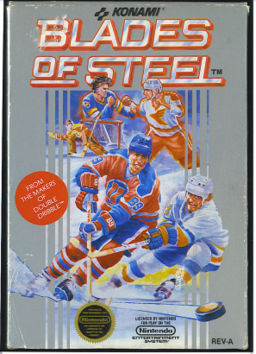 In other news, I woke up the morning wholly expecting this week’s Virtual Console lineup to be the kind of stuff dreams are made of. I was only somewhat disappointed. Blades of Steel, pictured to the left, is easily the winner this week, being my favourite hockey (sports?) game of all time. I bought Ice Hockey when it was released, but only because I never thought Blades would make it, but here it is, and here I am 500 Wii Points poorer. However, I now have Blades of Steel on my Wii, and that is totally worth the price of admission. Did I mention just how much I adore Blades of Steel?
In other news, I woke up the morning wholly expecting this week’s Virtual Console lineup to be the kind of stuff dreams are made of. I was only somewhat disappointed. Blades of Steel, pictured to the left, is easily the winner this week, being my favourite hockey (sports?) game of all time. I bought Ice Hockey when it was released, but only because I never thought Blades would make it, but here it is, and here I am 500 Wii Points poorer. However, I now have Blades of Steel on my Wii, and that is totally worth the price of admission. Did I mention just how much I adore Blades of Steel?






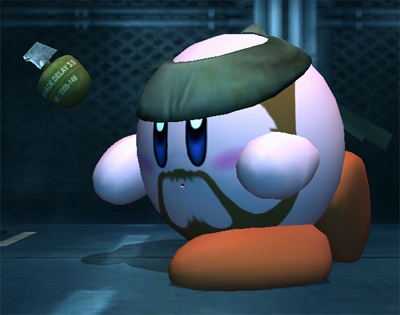
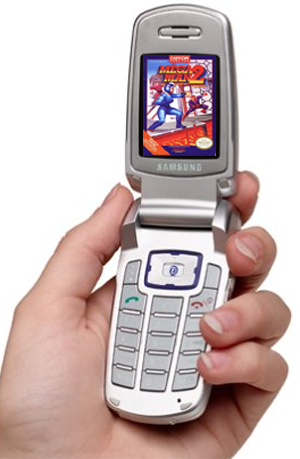 Ya heard me. I downloaded MegaMan 2 for my cell phone. It was a horrible idea and overexpensive, but I stand by my decision, because really, it’s not as bad as you might assume.
Ya heard me. I downloaded MegaMan 2 for my cell phone. It was a horrible idea and overexpensive, but I stand by my decision, because really, it’s not as bad as you might assume.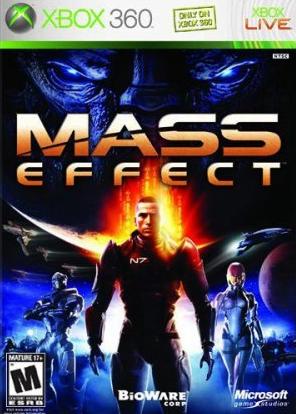 So it seems people just won’t shup up about Mass Effect. Before the game came out it was all hype, and now that it’s released it’s mostly nitpicking and disappointment. But me, I never cared about it at all. Until yesterday, when I stayed up playing until 7:00 AM. Yeah. The Tall One really wanted to rent it, despite “not having time for an RPG”. I think he just didn’t want to commit to Eternal Sonata. But anyhow, Mass Effect.
So it seems people just won’t shup up about Mass Effect. Before the game came out it was all hype, and now that it’s released it’s mostly nitpicking and disappointment. But me, I never cared about it at all. Until yesterday, when I stayed up playing until 7:00 AM. Yeah. The Tall One really wanted to rent it, despite “not having time for an RPG”. I think he just didn’t want to commit to Eternal Sonata. But anyhow, Mass Effect.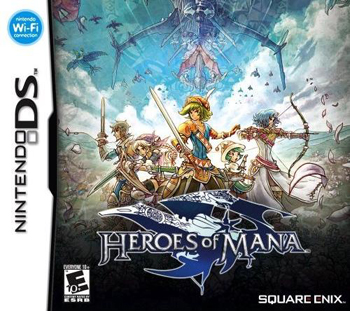 Ideally, RTS games should be great on the DS. The screen may be a bit smaller than the computer monitors that RTS players are used to, but the interface sure works a lot better than controllers do. Heroes of Mana isn’t the first RTS game on the DS, but it’s the only one so far that’s grabbed my attention. As great as it should be, it’s merely okay. Though declaring a Mana game “okay” is actually a compliment to the series these days.
Ideally, RTS games should be great on the DS. The screen may be a bit smaller than the computer monitors that RTS players are used to, but the interface sure works a lot better than controllers do. Heroes of Mana isn’t the first RTS game on the DS, but it’s the only one so far that’s grabbed my attention. As great as it should be, it’s merely okay. Though declaring a Mana game “okay” is actually a compliment to the series these days.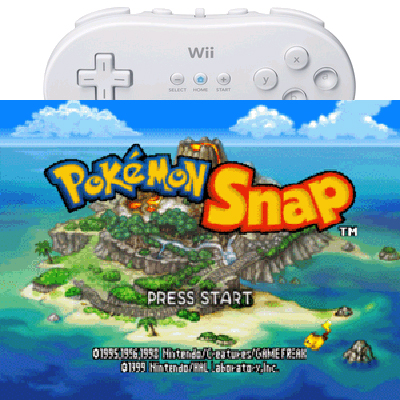 This entire story culminates in the game being released today on the Wii’s Virtual Console service. Swept up in the mania leading up to it’s release, I downloaded it myself, and played for about an hour tonight. Somewhat surprised, I actually got into the game again! Dunno how, but while Snap is short and doesn’t provide a ton of substance, it’s actually pretty interesting while it lasts. It isn’t one of the games I was really hoping for, but in the end, I’m of the opinion that this should have been on the VC long ago.
This entire story culminates in the game being released today on the Wii’s Virtual Console service. Swept up in the mania leading up to it’s release, I downloaded it myself, and played for about an hour tonight. Somewhat surprised, I actually got into the game again! Dunno how, but while Snap is short and doesn’t provide a ton of substance, it’s actually pretty interesting while it lasts. It isn’t one of the games I was really hoping for, but in the end, I’m of the opinion that this should have been on the VC long ago.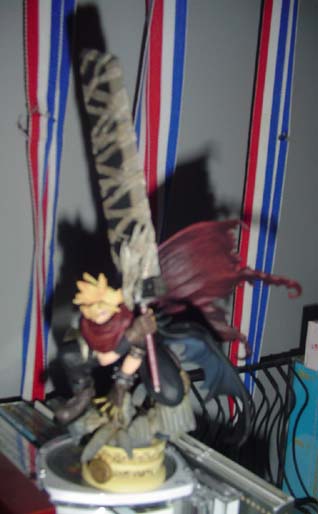 Yeah, it’s Cloud. But for the record, I likely wouldn’t have bought it if it had been a Final Fantasy collectible. Nope, it’s actually the only Kingdom Hearts figurine we’ve ever stocked at the Toys ‘R’ Us I work at, and frankly, I thought it was pretty cool. Plus, I really liked the Kingdom Hearts games.
Yeah, it’s Cloud. But for the record, I likely wouldn’t have bought it if it had been a Final Fantasy collectible. Nope, it’s actually the only Kingdom Hearts figurine we’ve ever stocked at the Toys ‘R’ Us I work at, and frankly, I thought it was pretty cool. Plus, I really liked the Kingdom Hearts games.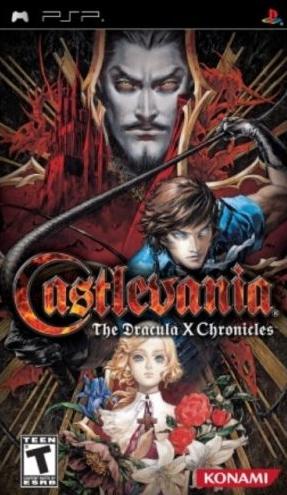 One of the main reasons I even bought the thing was because I heard the game pictured to the left of this paragraph was going to be made specifically for the handheld. Castlevania: The Dracula X Chronicles is a remake of one of the very few Vania games never to see light in North America, Rondo of Blood. You can head to a handful of the sites I ahve links to on the navi bar there, and get the whole drawn-out story on Rondo, so I’m going to concentrate on what I think of the game.
One of the main reasons I even bought the thing was because I heard the game pictured to the left of this paragraph was going to be made specifically for the handheld. Castlevania: The Dracula X Chronicles is a remake of one of the very few Vania games never to see light in North America, Rondo of Blood. You can head to a handful of the sites I ahve links to on the navi bar there, and get the whole drawn-out story on Rondo, so I’m going to concentrate on what I think of the game.